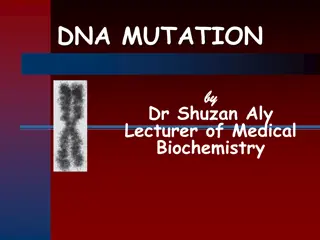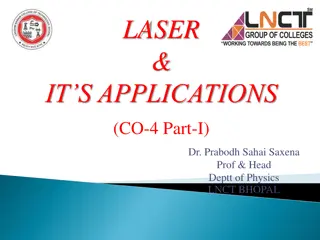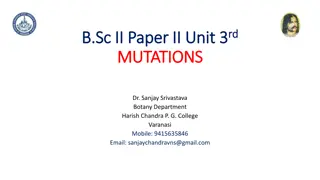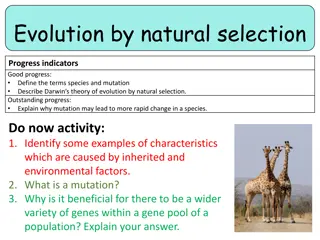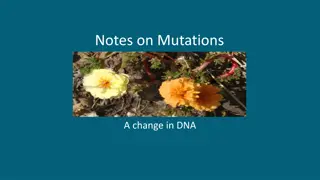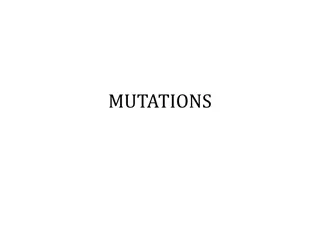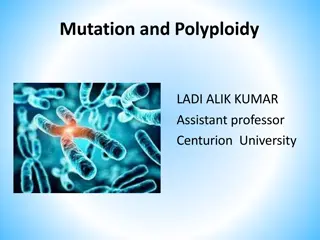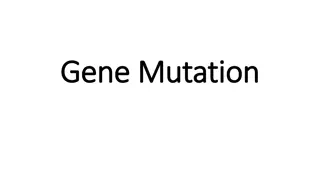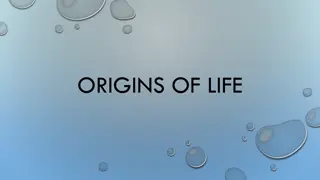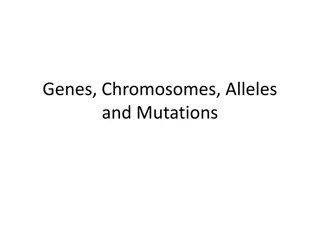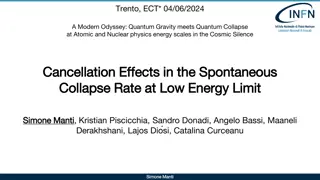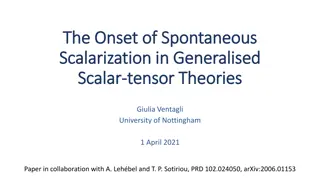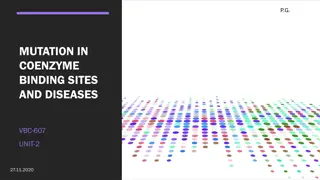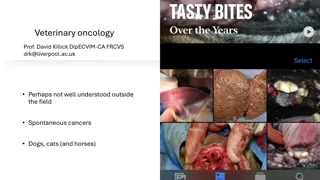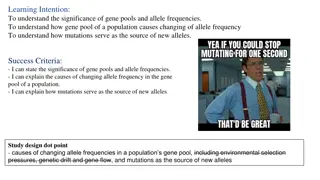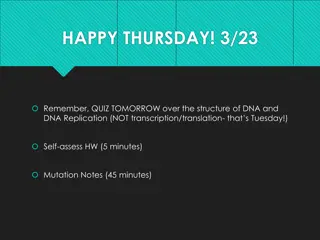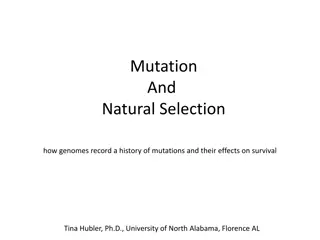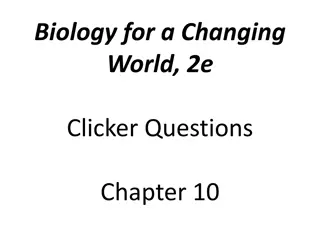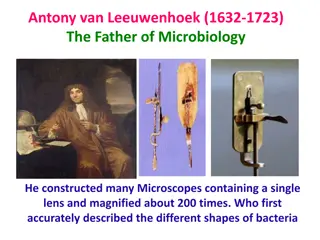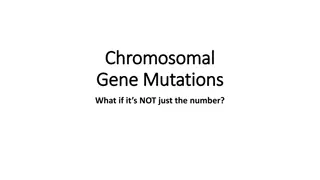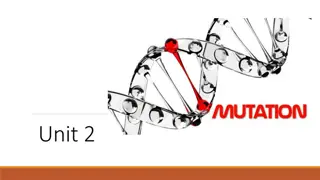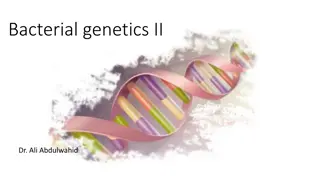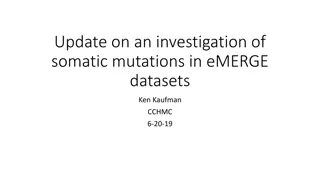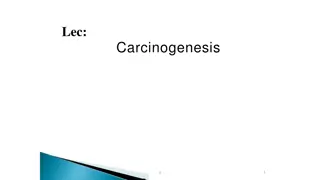Understanding DNA Mutations and Their Types
DNA mutations are changes in the DNA molecule that can lead to permanent alterations in the base sequence of daughter DNA. Causes include uncorrected errors, as well as damage from oxidative deamination, radiation, and chemicals. The types of mutations include point mutations, insertion mutations, d
4 views • 7 slides
Clinical Update on Management of Spontaneous Intracerebral Hemorrhage
This clinical update, adapted from the 2022 guideline by the American Heart Association and American Stroke Association, covers a comprehensive range of topics related to the management of patients with spontaneous intracerebral hemorrhage. It includes information on population health implications,
0 views • 38 slides
Understanding Laser Technology: Principles, Applications, and Einstein's Coefficients
Exploring the fascinating world of lasers, this content delves into the principles governing laser technology, including the concept of stimulated emission by Einstein. It covers the characteristics of lasers, different types, and the significant contributions of pioneers in the field. The explanati
0 views • 14 slides
Understanding Mutations: Types, Characteristics, and Examples
Mutations are changes in the genetic material that can affect an organism's traits. This article explores gene mutations, their historical background, characteristics, kinds of mutations like spontaneous and induced, somatic and germinal mutations, and conditional lethal mutations. It also covers ge
2 views • 18 slides
Understanding Evolution by Natural Selection
Explore the concepts of species, mutation, Darwin's theory of evolution, and the role of genetic variation through mutations. Learn how mutations can lead to rapid changes in species and why a wider variety of genes in a gene pool benefits a population. Delve into the effects of mutations on individ
0 views • 15 slides
Understanding Mutations in DNA and Their Effects
Mutations in DNA are changes that can occur in body cells or gametes, leading to alterations in the genetic code. Not all mutations are harmful, but they can impact protein structure and function. Different types of mutations, such as substitutions, insertions, and deletions, can result from various
0 views • 11 slides
Understanding Genetics: Mutations, Chromosomal Aberrations, and Genetic Engineering
Genetic mutations can be harmless, harmful, or beneficial, leading to variations within a species. Examples of gene mutations and chromosomal aberrations, like Trisomy 21, illustrate genetic abnormalities. The increase in Down Syndrome cases with maternal age highlights a maternal age effect. Geneti
0 views • 17 slides
Understanding Microbial Genetics and Mutations in Organisms
Explore the world of microbial genetics with Dr. Abhishek Thakur, an Assistant Professor specializing in Microbial Genetics at the College of Fisheries, Kishjanganj, BASU, Patna. Learn about important concepts such as strains, clones, genome, phenotype, genotype, genes, genetic recombination, and mu
0 views • 19 slides
Understanding Mutations in Biology
A mutation in biology refers to changes in the nucleotide sequence of an organism's genome. These alterations can either be harmful, leading to conditions like cancer, or beneficial, such as providing antibiotic resistance. Mutations can occur in somatic cells or gametes, affecting both the individu
1 views • 18 slides
Understanding Mutation and Polyploidy in Genetics
Mutation is a sudden hereditary change in an organism's genetic makeup, leading to variations in offspring. This article delves into the history, types, and causes of mutations, featuring significant discoveries by scientists like De Vries and Morgan. It also explores the concept of spontaneous muta
0 views • 50 slides
Understanding Gene Mutations in Molecular Biology
Gene mutations play a significant role in molecular biology, leading to alterations in DNA sequences that can impact offspring. These mutations can arise spontaneously or be induced by various factors, such as mutagens. Understanding gene mutations is crucial for comprehending the genetic basis of c
2 views • 27 slides
Understanding the Principle and Working of Semiconductor Lasers
Semiconductor lasers operate through absorption, spontaneous emission, and stimulated emission processes. Absorption of radiation causes electrons to jump to higher energy levels, leading to light emission. Spontaneous emission is when excited electrons return to ground state by emitting photons, wh
3 views • 17 slides
Understanding Gene Mutations and Their Impact on DNA Sequences
Gene mutations are changes in the nucleotide sequence of DNA, leading to potential amino acid alterations in proteins. These mutations can occur due to replication errors or external factors like chemicals and radiation. Different types of mutations, such as base substitutions, transitions, transver
0 views • 11 slides
Semi-Automatic Analysis of Spontaneous Language for Dutch
Develop an application to semi-automatically analyze spontaneous language transcripts for Dutch, focusing on language development disorders such as aphasia. The goal is to automate the manual analysis process using language technology, with methods like TARSP, STAP, and ASTA. The SASTA application a
0 views • 39 slides
Evolutionary Journey: From Spontaneous Generation to Endosymbiont Theory
Explore the fascinating evolution of life from early beliefs in spontaneous generation to the modern Miller-Urey experiments demonstrating simple organic molecule formation. Learn about the transition to biogenesis theory, cellular evolution, and the groundbreaking endosymbiont theory proposed by Ly
1 views • 9 slides
The Evolution of Spontaneous Generation: A Scientific Journey
Explore the historical progression of the Spontaneous Generation theory through the experiments and discoveries of scientists like Redi, Spallanzani, and Pasteur. Witness the shift from the belief that living things can arise from non-living matter to the establishment of biogenesis principles. Foll
2 views • 25 slides
Understanding Genes, Chromosomes, Alleles, and Mutations in DNA
Explore the intricate world of genetics through genes, chromosomes, alleles, and mutations. Delve into the fundamental structures of DNA, such as nucleosomes and eukaryotic chromosomes. Gain insights into key genetic terms like genes, alleles, and genome composition. Learn about mutations, including
0 views • 11 slides
Understanding Mutations: Types and Effects
Explore the world of mutations in this informative content covering topics such as how superheroes like Cyclops, Hulk, and Spiderman acquired their powers, the different types of mutations including small-scale mutations like substitution, deletion, and insertion, as well as large-scale mutations af
0 views • 23 slides
Detection of Mutations in EGFR in Circulating Lung Cancer Cells: Study on SARMS Assay and CTC-Chip
This study by Shyamala Maherswaran, Ph.D., and team focuses on characterizing mutations in EGFR in circulating tumor cells using SARMS assay and CTC-chip. The research investigates the effectiveness of these non-invasive methods in analyzing tumors and explores the role of the T790M mutation in resp
0 views • 12 slides
Engaging Team Building Activity: Spontaneous Storytelling for Connection and Cultural Appreciation
Enhance team bonding through a creative activity of spontaneous storytelling using visual prompts. Encourage understanding, respect, and appreciation for different cultures while fostering a positive attitude towards diversity. Support each other to build a cohesive narrative and enjoy the power of
0 views • 15 slides
How Private Charters Offer Flexibility for Spontaneous Travel Plans_
Need a last-minute getaway? Private charters offer unparalleled flexibility and luxury. Discover how these personalized journeys can turn your spontaneous travel dreams into reality.
0 views • 6 slides
Investigating Quantum Collapse and Spontaneous Radiation at Low Energy Scales
Delve into the realm where Quantum Gravity meets Quantum Collapse, exploring the Cosmic Silence Cancellation Effects and the Spontaneous Collapse Rate at Low Energy Limits. Models like Continuous Spontaneous Localization and Dio.si-Penrose propose solutions to the macroscopic observation challenge i
0 views • 20 slides
Understanding Mutations: Types, Causes, and Significance
Explore the world of gene mutations and chromosome mutations, including point mutations, frameshift mutations, and changes in chromosome structure. Learn about the significance of mutations, how they can be inherited or acquired, and their impact on genetic information. Uncover examples of neutral,
0 views • 9 slides
Understanding Spontaneous Scalarization in Gravitational Theories
Spontaneous scalarization presents a unique phenomenon where compact objects experience field growth triggered by tachyonic instability, leading to stable field configurations. Explored in various theories, such as Horndeski gravity and scalar Gauss-Bonnet gravity, spontaneous scalarization is studi
0 views • 18 slides
Voice-Induced Vowel Lengthening in Phonology Research
Exploring the phenomenon of voice-induced vowel lengthening, this research delves into spontaneous vs. non-spontaneous voicing patterns and the documented transmission of voicing from vowels/sonorants to voiceless obstruents. The study discusses various theories on voice transmission from sonorants/
2 views • 35 slides
Mutations in Coenzyme Binding Sites and Related Diseases
Mutations in coenzyme binding sites can lead to diseases by impacting enzyme affinity and reaction rates. Defects in proteins like ornithine aminotransferase and cystathionine-synthase result in conditions such as gyrate atrophy of the choroid and retina, homocystinuria, and X-linked sideroblastic a
0 views • 14 slides
Advances in Veterinary Oncology: Understanding and Treating Spontaneous Cancers in Animals
Veterinary oncology, led by Prof. David Killick, delves into the realm of spontaneous cancers in dogs, cats, and horses, mirroring the cancer evolution in humans. The field covers diagnosis through cytology and imaging to treatments like surgery, radiation, and emerging immunotherapy. University vet
0 views • 11 slides
Exploring Inhibited Spontaneous Emission in Physics
The study delves into inhibited spontaneous emission in physics, focusing on the phenomena, experimental setups, and effects like the Purcell effect. It discusses using waveguides and Rydberg atoms for this purpose, as well as the density of modes and states in free space and cavity configurations.
0 views • 16 slides
Understanding Gene Pools, Allele Frequencies, and Mutations in Population Genetics
Dive into the significance of gene pools and allele frequencies, exploring how mutations drive the emergence of new alleles. Learn about factors impacting allele frequencies like mutations, environmental pressures, genetic drift, and gene flow. Discover the types of mutations and their effects on po
0 views • 13 slides
Understanding Mutations and Their Effects on DNA
Learn about the structure of DNA, DNA replication, and various types of mutations such as substitution, deletion, and insertion. Explore how mutations occur, their effects at the molecular level, and how environmental factors can influence them. Discover the impact of mutations through examples of s
0 views • 17 slides
Understanding Mutations and Natural Selection in Genomes
Explore how mutations impact survival and how genomes record these changes, distinguishing between functional and nonfunctional sequences. Learn about the effects of mutations on organism survival and the role of natural selection in shaping genetic variability.
0 views • 11 slides
Empowered Evangelism: Spontaneous or Strategic?
Explore the dynamic between spontaneous and strategic evangelism within the context of church renewal in the USA/Canada region of the Church of the Nazarene. Delve into how the early Church responded to persecution, scattering disciples and leading to the spread of the Gospel. Reflect on the signifi
0 views • 25 slides
Understanding Mutations in Biology: Clicker Questions Explained
Explore a series of clicker questions related to mutations in biology, covering topics such as the definition of mutations, their effects, inheritance patterns, and the impact on amino acid sequences. Gain insights into how mutations occur, their consequences, and their role in genetic processes.
0 views • 18 slides
Pioneers of Microbiology: Leeuwenhoek, Redi, Pasteur
Antony van Leeuwenhoek, the Father of Microbiology, pioneered the use of microscopes to describe bacteria shapes. Francesco Redi and Louis Pasteur conducted experiments to oppose the theory of spontaneous generation. While Redi disproved maggots' spontaneous generation, Pasteur's work led to breakth
0 views • 20 slides
Understanding Chromosomal and Gene Mutations in Genetics
Chromosomal and gene mutations play a crucial role in genetic variations. Mutations such as insertion, deletion, and substitution can lead to significant changes in DNA sequences, affecting gene expression and cellular functions. Additionally, chromosomal mutations like deletion, amplification, inve
0 views • 15 slides
Understanding Genetic Mutation and Its Impact on Evolution
Genetic mutations are a natural process that introduces variations in DNA sequences, creating new alleles and genetic diversity within populations. These mutations can have both positive and negative effects on individuals, influencing survival and reproduction. By examining different types of mutat
0 views • 28 slides
Understanding Bacterial Genetics: Phenotypic and Genotypic Variability
Phenotypic and genotypic variations in bacteria are crucial for their adaptation and survival. Phenotype reflects the physical expression influenced by both the genome and the environment, while genotype represents the hereditary constitution passed to offspring. Mutations are a primary source of ge
0 views • 23 slides
Comprehensive Analysis of Somatic Mutations in eMERGE Datasets
This investigation delves into somatic mutations across normal tissues, revealing macroscopic clonal expansions. The study processed a large number of samples and identified candidate mutations, with characteristics and functional predictions detailed. Genes with the most somatic mutations are highl
0 views • 24 slides
Understanding the Fundamentals of Carcinogenesis and Cancer Hallmarks
Carcinogenesis involves non-lethal genetic damage, clonal expansion of precursor cells, and multi-step processes, with the involvement of normal regulatory genes. The hallmarks of cancer include self-sufficiency in growth signals, insensitivity to inhibitory signals, evasion of cell death, replicati
0 views • 16 slides
Understanding Causes of Mutations and Repair Mechanisms
Mutations can be classified into spontaneous and induced mutations based on their origin. Spontaneous mutations occur naturally, while induced mutations are caused by mutagens. Understanding the causes of mutations and repair mechanisms is vital in studying genetic variation and disease development.
0 views • 13 slides
